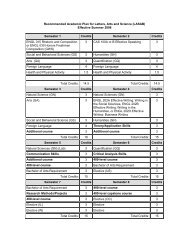Vol. III - Penn State Abington
Vol. III - Penn State Abington
Vol. III - Penn State Abington
You also want an ePaper? Increase the reach of your titles
YUMPU automatically turns print PDFs into web optimized ePapers that Google loves.
powerful forces in the financial market, there was little regulation of these credit rating agencies<br />
for a long time.<br />
Failure of Accommodating to the New Financial Derivatives<br />
In an economic boom, the earnings from structured finance products based on the<br />
subprime mortgage can be comparatively stable, because of the combination of financial pools<br />
with different risks. But in an economic downturn as we have now, the funds from the subprime<br />
mortgage to these products will shrink sharply, as there is a high correlation among these<br />
mortgages (Strier, 2008:533-53). Thus these structured financial products are more sensitive to<br />
the economic environment than traditional corporate or municipal bonds.<br />
So if the CRAs go ahead and rate these novel instruments which no one has ever known<br />
how to rate, it’s difficult to estimate to what extend the CRAs are risking their reputation to<br />
benefit from these ratings. Their failure to forecast the risk for structured finance does not show<br />
that their ratings on traditional corporate and municipal bonds are unreliable. Accordingly,<br />
issuers and investors are not likely to cast doubt on the CRAs’ traditional ratings after their<br />
failure in novel instruments. From the Chart above, Moody’s loss after the subprime mortgage<br />
crisis was derived mainly from the structured finance products, while its revenue from traditional<br />
ratings has not been affected. This was also illustrated by the continual prosperity of the CRAs<br />
after the Enron Scandal. However, there is a risk here that the CRAs may take no actions to<br />
adjust their methodologies or criteria catering to novel financial instruments if they know no one<br />
will really look into their responsibility.<br />
Possible Solutions<br />
1) Information Disclosure<br />
When the U.S. government noticed potential conflicts of interest with the relationships of<br />
bond issuers, CRAs and investors, it tried to solve this problem by strengthening information<br />
disclosure. The Credit Agency Reform Act passed in September 2006 intended to protect<br />
investors. NRSRO’s obligation to expose information to the public was stressed (Credit Rating<br />
Agency Reform Act, 2006). In July 2008 after the subprime mortgage crisis emerged, the SEC<br />
published a report on the big three CRAs. This report stated that significant aspects of the rating<br />
process and the underlying data based on which ratings are made should be sufficiently<br />
documented and disclosed (U.S. Securities and Exchange Commission, 2008:13).<br />
Of course, information disclosure is an important part of the solution, because it allows<br />
for regulation by government and competitors, and the assessments of investors. The regulators<br />
have emphasized the importance of transparency of methodologies, models and weighting of key<br />
parameters of the CRAs. However, there’s a question if complete information disclosure will<br />
improve the competition of the credit rating market as well as the quality of rating reports. One<br />
problem is that different credit rating agencies have their own methodologies, model<br />
consumptions, etc, although they may not be totally different (U.S. Securities and Exchange<br />
Commission, 2008:13).<br />
In fact, CRAs consider their methodologies and models unique and part of their<br />
competitive edge. What is worse is that CRA may lose their incentives to innovate new rating<br />
methods and instruments to improve the accuracy of their rating reports, especially when the<br />
THE DIALECTICS ▲ 2009<br />
www.abington.psu.edu/dialectics<br />
35







